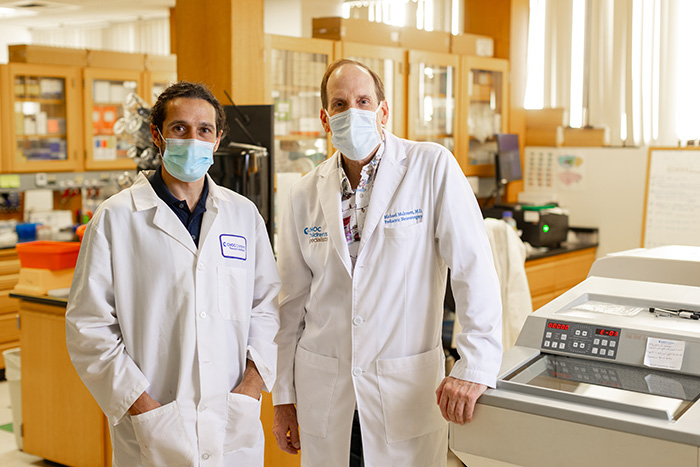In another win for CHOC’s growing and robust hydrocephalus program, the Department of Defense has awarded a grant to the CHOC Neuroscience Institute to study a non-surgical way to treat the debilitating and complex disease.
The $1.56-million, four-year award is the first for CHOC researchers from the Department of Defense, which is seeking new treatments for hydrocephalus and other diseases, many of them rare, for which the military population is particularly vulnerable.
“The level of science that is being performed at CHOC to help children with hydrocephalus is world class, as evidenced by this very competitive award,” said neurologist Dr. John Crawford, co-director of the CHOC Neuroscience Institute.
Dr. Leandro Castañeyra-Ruiz, asenior scientist in CHOC’s hydrocephalus research laboratory, will lead the research effort.
In the military, babies born within six months of a parent’s return from deployment have twice the chance of arriving preterm, according to the Department of Defense. Preterm infants present a higher risk than full-term babies to develop brain bleeding and, subsequently, hydrocephalus.
The grant to CHOC is an example of the agency’s efforts to help develop novel treatments for pediatric and adult diseases.

Could a compound be the answer?
With a keen biological interest in what is happening in the brain that triggers hydrocephalus, Dr. Castañeyra-Ruiz’s study will focus on the role of calpain, an enzyme that helps break down proteins into smaller pieces.
Hydrocephalus, the buildup of fluid in the ventricles deep within the brain, often results from inflammatory conditions like brain infections or bleeding in premature infants when their immune system is underdeveloped.
“We believe that calpain overactivity during inflammation damages the cell junctions important to maintaining brain structure and functionality, leading to fluid buildup,” Dr. Castañeyra-Ruiz explained. “Our hypothesis is that stopping calpain with a compound called calpeptin can prevent this damage and, consequently, hydrocephalus.”
Castañeyra-Ruiz said his team has shown calpeptin to be effective in preliminary experimental conditions to treat hydrocephalus.
High failure rate
The current surgical method to treat hydrocephalus is cerebrospinal fluid (CSF) shunting, which allows excess cerebrospinal fluid to drain into the abdominal cavity or heart where it can be absorbed naturally by the body and relieve pressure on the brain.
But CSF shunting has high failure rates and complications. Around half the implants fail within the first two years of implantations, leading to significant morbidity and numerous surgeries.
“These shunting devices, which include catheters, fail way too often,” Dr. Castañeyra-Ruiz noted.
A record of success
In less than five years since the inception of CHOC’s hydrocephalus research program, led by pediatric neurosurgeon Dr. Michael Muhonen, the lab has successfully landed several federal grants, including one from the NIH.
In addition, the lab has received foundational and donor support and has published multiple articles in prestigious peer-reviewed journals. The lab also has mentored a small army of the next generation of scientists by placing them in paid or volunteer laboratory research positions.
“This grant is confirmation from scientists outside of the institution that our hydrocephalus laboratory is doing seminal, high-quality research,” Dr. Muhonen said, adding that the goal of his laboratory is to “cure” hydrocephalus and hopefully prevent it from happening.
“The multi-causal nature of the disease makes a cure a seemingly impossible challenge,” Dr. Muhonen said. “However, this DOD grant allows us to make giant steps toward prevention of secondary hydrocephalus – for example, from a cerebral bleed in premature infants, or an infection such as meningitis.”
Dr. Muhonen added that as his lab makes progress toward prevention of hydrocephalus, his team continue to work to improve the existing shunting devices, with the ultimate goal of obviating the need for shunts all together.
“I am extremely proud of my research team, and am grateful to the dedicated families, CHOC research associates, and government agencies that have supported us in our research efforts,” Dr. Muhonen said.
A focus on research
Dr. Castañeyra-Ruiz joined Dr. Muhonen’s lab 3 ½ years ago. Along with Dr. Muhonen and Dr. Seunghyun Lee, a research scientist and an electrical engineer, he has been a key player in the program’s growth.
For example, Dr. Castañeyra-Ruiz was the recipient of a Chief Scientific Officer (CSO) grant that led to him gathering preliminary data that found that premature babies have an elevated risk of developing a hemorrhage in the brain and thus are highly likely to develop hydrocephalus.
“At CHOC, our goal is to go beyond the ordinary to help our children grow and thrive,” said Chief Scientific Officer Dr. Terence Sanger, who launched the CSO grant program shortly after he joined CHOC in 2020.
“This research project is a significant step toward that goal, and we are thrilled that this and other research programs at CHOC are having such an important impact,” Dr. Sanger added.
Dr. Castañeyra-Ruiz said it took several attempts for CHOC to win the Department of Defense grant and said is thankful for the Hydrocephalus Association (HA) for walking him through the grant application process.
“This is the biggest achievement of my career,” he said. “I’m very proud.”

CHOC Hospital was named one of the nation’s best children’s hospitals by U.S. News & World Report in its 2025-26 Best Children’s Hospitals rankings and ranked in the neurology/neurosurgery specialty.




